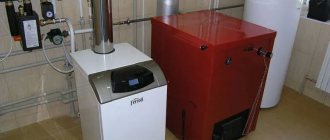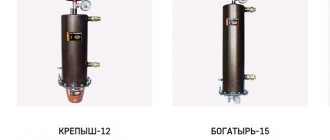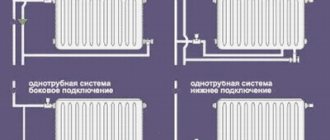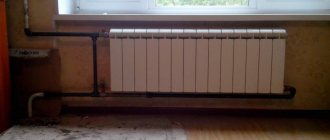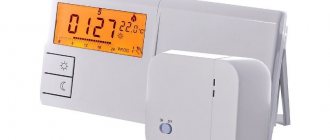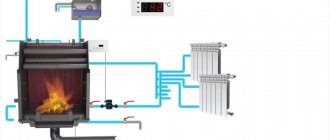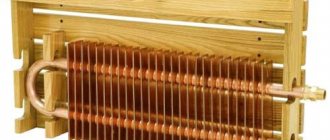The vast majority of heating systems for private houses are built according to a scheme in which the boiler is heated by a thermal agent, which releases energy into radiators or “warm floor” pipes.
If the coolant for the heating system meets the operating conditions, the service life of heating devices increases and emergency situations are eliminated. Water or antifreeze of various chemical compositions are used as a coolant. The property owner needs to objectively evaluate what is most suitable for use.
Coolant requirements
The safety and efficiency of using a heating agent depends on its consumer qualities and technical data.
Coolant requirements:
- high thermal capacity – the ability to quickly heat up and transfer heat;
- neutrality or minimal chemical reactions with equipment materials;
- a wide range of operating temperatures at which the state of aggregation does not change;
- no scale formation during prolonged exposure to high temperatures;
- stability of chemical composition;
- constancy of fluidity and thermal capacity for the entire period of operation declared by the manufacturer;
- safety for users – the absence of toxic, flammable, radioactive and explosive substances in the composition or the impossibility of their formation.
There are subtleties of choice depending on the equipment used. For example, distilled water and most of the range of antifreezes and antifreezes cannot be used for electrode boilers.
What should the coolant be?
If you have a question about how to fill the heating system in your personal home, then you must figure out what the coolant should be. No model liquid for this role has yet been invented. This indicates that any of the popular materials is in use under specific conditions.
A significant factor is the temperature of the coolant, if violated, the substance can change its own properties, which leads to the system stopping. A good thermal fluid should transfer a decent amount of heat in the shortest possible time, it should have low viscosity, it should not cause corrosion and it should not pose a danger to the inhabitants of the house. In addition, when transferring heat, heat loss must be very small, and low viscosity will be an indicator of the pumping speed and increase in efficiency.
If you are faced with the question of how to fill the heating system in your personal home, you must know that one or another coolant will cause corrosion, due to which you will encounter restrictions when choosing mechanisms and parts of the system.
Is ordinary water sufficient as a coolant?
Water is one of the best coolants for a country house system.
| Advantages | Flaws |
| High heat capacity, better only with distilled water | Freezing at temperatures below 0°C, which does not allow use in equipment operating intermittently and will require draining during prolonged interruptions in the coolant supply |
| Everywhere Availability | Allows a high degree of oxygen saturation, which accelerates corrosion |
| Low cost - there are practically no costs for filling the system | Accelerated formation of scale and build-up when using water from external sources (wells, boreholes), as well as with poor quality water treatment |
| Stable fluidity and heat capacity at different temperatures | |
| Safety – does not emit toxic substances, does not burn, does not explode |
In most cases, deficiencies can be eliminated using simple water treatment methods.
Technical requirements for water for use in the heating system
The exact requirements for water quality for centralized systems (which can also be followed by owners of private houses) are determined by Order of the State Construction Committee of the Russian Federation No. 285 dated December 13, 2000.
The document defines the maximum values:
- free carbonic acid content – 0;
- pH (acidity level) – 8.3-9.0 for open heating systems, 8.3-9.5 for closed ones;
- iron compounds mg/kg no more than 0.3 for open and 0.5 for closed types of heating construction;
- dissolved oxygen – 20 mcg/kg;
- suspended substances – 5 mg/kg;
- petroleum products – 0.3 mg/kg for open and 1 mg/kg for closed systems.
Measurements are carried out 2 times a year on centralized networks and it is advisable to do this before the start of the heating season in private homes.
The intensity of corrosion can be understood by changes in the content of carbon dioxide, dissolved oxygen and the amount of iron compounds. Indirect signs of deposits are increasing values of calcium and total hardness, bicarbonate and total alkalinity, as well as the content of iron sulfates.
When it is not possible to obtain clean coolant (for example, from a well), you can purchase water already prepared for the heating system. The asking price is 200-300 rubles. for 10 l. coolant.
How to improve important water indicators
Some characteristics of coolant water can be improved at home.
Available methods:
- boiling, freezing, distillation, settling;
- use of mechanical filters;
- use of filters with inhibitors (neutralizers);
- adding chemical reagents;
- catalytic oxidation of iron and its removal into sediment;
- deaeration.
- treatment with electromagnetic waves or a permanent magnet at a coolant temperature of up to 70°C.
Important! Soft, demineralized water with a pH below 6.5 is harmful to heating systems with steel components (pipes, expansion tank). Calcium salts reduce the intensity of acid reactions that accelerate the appearance of rust.
Types of water filters
Not all types of filters sold are effective. The use of some types is irrational in heating systems - while improving performance and making water suitable for drinking, they do not improve the qualities required in heating systems.
The most affordable product for home water treatment is a polyphosphate filter (softener) , costing from 600 rubles. The price of a portion of backfill starts from 200 rubles.
Simplified connection diagram for a softening filter.
The operating principle is based on “enveloping” hardness salts with a phosphate film, which prevents the formation of scale.
The filter is installed so that water from the water supply or well enters the heating system. One fill is enough to soften up to 100 tons of water, or for a year of use by a family of 3-5 people.
Attention! After passing through the polyphosphate filter, the water becomes unfit for drinking.
Magnetic filters are installed in front of the boiler. Passing through the device, the water briefly changes its properties and sludge is formed in the heating zone, which is not deposited on the walls of the heating devices. The sediment is retained by the filter and removed by blowing. Cost - from 1,700 for domestic and up to 10,000 rubles. for imported products.
Reverse osmosis is an effective purification method. Using the device only to recharge the heating system is ineffective and, considering the price (from 5,000 rubles), expensive. In practice, water is purified by reverse osmosis and pumped into the system through a make-up tap.
Mechanical filters with membranes or backfill are used to remove sand, clay, zooplankton and organic compounds. Cost – from 900 rubles, price of cartridges – from 150 rubles.
Important! Mechanical filters do not soften water, but only purify it from suspended impurities.
Boiler water is not antifreeze, freezes at 0°C and cannot be used in houses with periodically switched off heating.
How to choose a water softener for a gas boiler and extend the life of the heat exchanger
List of alternatives
What other liquids can be used as a coolant:
Tap water taken from a well, pond or well. This option is beneficial in terms of the financial component, since it is the cheapest. However, such filling can quickly damage the heating system due to aggressive effects.- Boiled water. This allows salts and oxygen to be partially neutralized. The downside is that it is problematic to boil the large volume of liquid required to fill the circuit.
- Water that has been purified with reagents. Instead of boiling, you can purify water using reagents. Such water must be thoroughly filtered before using it for its intended purpose.
- Antifreeze. They are used when the heating system is prone to freezing. The temperature threshold for solidification of antifreeze is significantly lower than that of distilled and ordinary water. Only this method is rarely used due to the high cost of the coolant.
Types of specially prepared compounds - antifreeze
Antifreeze is not drained during long-term power outages, as well as in summer cottages and garages. Special additives prevent freezing, reduce or eliminate scale formation, and stabilize fluidity at different temperatures.
Depending on the composition, propylene glycol and ethylene glycol glycerin compositions are distinguished.
Attention! When choosing antifreeze, be sure to take into account the manufacturer's recommendations. In some cases, the use of substances leads to denial of warranty service. For example, the use of antifreeze is prohibited in some double-circuit boilers.
Propylene glycol
An alcoholic liquid that is completely harmless to humans. Propylene glycol is a food additive E1520.
Important characteristics:
- freezing temperature – 60°C;
- boiling point – 187°C;
- density – 1037 kg/m3;
- specific heat capacity – 2,483 J/kg*K (for comparison, for water – 4,187).
Propylene glycol is characterized by increased fluidity, so high demands are placed on the tightness of connections. The harmlessness of liquids and vapors allows use in open heating systems.
Propylene glycol antifreeze is not used in heating systems with galvanized pipes due to accelerated oxidation and destruction of the protective layer.
The use is limited by the high price.
Ethylene glycol
Ethylene glycol is a colorless, odorless, oily liquid with a sweetish taste. For humans, ethylene glycol is extremely toxic and toxic in liquid and vapor states.
Ethylene glycol antifreeze is prohibited from being poured into open heating systems, or used in double-circuit systems with hot water preparation, where there is a risk of mixing the coolant.
Antifreeze is produced in diluted and concentrated forms. In the first case, the permissible negative temperature is up to -30°C, for concentrates – up to -65°C.
Features of operation:
- boiling and foaming of ethylene glycol heated to 90-95°C, leading to the formation of gas plugs;
- prohibited for use in systems with galvanized pipes;
- decomposition with loss of properties when heated to 110°C, possible formation of an insoluble precipitate.
These disadvantages reduce the popularity of ethylene glycol antifreeze.
When diluted with water, all important properties are preserved, except for the freezing point - the lower the concentration of the substance, the higher the freezing point.
Glycerol
Glycerin is a trihydric alcohol; in small quantities the substance can be used as a food additive.
Among the advantages are noted:
- operating temperature range – from -30 to +110°C;
- does not destroy pipes when frozen;
- does not pollute the heating system;
- properties are restored after defrosting.
Glycerin antifreezes have increased viscosity, which reduces the likelihood of leaks, but requires the installation of high-power circulation pumps.
With long-term use, glycerin thickens, so it requires regular checking and replacement if necessary.
Is it permissible to use antifreeze?
Antifreeze is an ethylene glycol antifreeze that is poisonous when evaporated.
Compared to water, antifreeze has one advantage - it does not freeze at temperatures down to -40°C (depending on the concentration).
Other parameters have a negative effect on heating operation:
- Low heat capacity increases energy costs.
- Increased viscosity will require the installation of higher power circulation pumps.
- High fluidity causes leakage through microcracks.
- Cannot be used in double-circuit and open heating systems.
- Large volumetric expansion – tanks of increased capacity are required.
The price of antifreeze is comparable to the cost of specialized antifreeze; choosing the former is irrational. Cheap antifreeze purchased on highways may not meet the stated parameters.
Antifreeze for electrode (ion) boilers
Branded coolant from the manufacturer Galan.
At the time of writing, the cost of such a canister is about 2,200 rubles. In electrode boilers, the coolant is heated by current passing between the electrodes. Operation of the equipment in the specified mode is possible only with a suitable electrolyte.
As a rule, equipment manufacturers require filling with their own brand of antifreeze. This entails additional costs, since strictly specialized formulations are more expensive.
Two types of coolants are used for refueling:
- ethylene glycol based antifreezes;
- distilled water with added table salt.
Open systems with an electrode boiler are filled with water and salt; closed systems can be filled with ethylene glycol.
How to choose a coolant for an individual system in a private home
Heating systems in a private home are operated under different conditions.
When choosing a heating agent, consider:
- Boiling point . Gas and electric boilers in private homes heat the coolant up to 90°C; water and any antifreeze are suitable for filling. In systems with solid fuel boilers, it is difficult to control the temperature, and it is undesirable to use antifreeze.
- Crystallization temperature is usually indicated in the name. The formation of crystals or powder prevents the destruction of system elements. With a further decrease in temperature, the liquid finally freezes - the difference is 8°C.
- The service life is indicated in the passport or on the packaging. It is advisable to check the declared indicators before the start of the heating season. A change in color or viscosity indicates impaired performance.
- Not all antifreezes can be diluted or mixed . Before such manipulations, you must study the instructions.
In addition to the characteristics, the requirements of the heating equipment manufacturer must be taken into account.
How to choose a room thermostat and save up to 30% per month on heating
Glycol solutions are the future
Is there a coolant that has virtually no obvious disadvantages? These can be considered coolants based on glycol solutions. Their freezing temperature can reach 60 degrees below zero, and the nonlinear nature of the relationship between crystallization conditions and concentration allows for savings. There is no longer any need to purchase a concentrated glycol solution, because for normal operation of the engineering system, a composition with a concentration of about 70% is sufficient. It all depends on the specifics of the equipment and operating conditions, but with the addition of a package of organic additives, a water-glycol solution can become a universal antifreeze for all occasions.
The use of additives is an important point that allows you to minimize the highly corrosive activity of a glycol solution. For this purpose, carboxylate compounds are used from a well-known manufacturer from Belgium - the Arteco concern. The range of products for heating and air conditioning systems of various facilities includes:
- Water-glycol solutions of selected concentration with a package of additives. For convenience, the coolant is supplied both in special containers and in bulk. The company has equipped vehicles that can deliver antifreeze for replacement or dispose of waste fluid from the system.
- Ready-made coolants under the Hot Stream brand based on ethylene and propylene glycol solutions. The variety of compositions allows everyone to find an option for open or closed engineering systems with different temperature operating conditions.
Minimum required amount of coolant
An accurate calculation of the amount of coolant will help you avoid visiting the store again or waiting for a new delivery of products ordered on the Internet.
The total volume consists of the capacity:
- gas boiler;
- pipes;
- radiators;
- expansion tank.
The parameters of boilers and radiators are indicated in the passports. About 20% should be subtracted from the capacity of the expansion tank.
The internal volume of pipes can be found in reference tables or calculated independently using formulas from a school mathematics course.
An example of such a table from one of the pipe manufacturers.
Steel pipes are marked according to the outer diameter, plastic pipes - according to the inner diameter.
Normal operation of the boiler is achieved in cases where the amount of coolant is correctly calculated.
The ratio is approximately this: for each kW of boiler power there should be 15 liters of coolant. If the ratio is lower, the efficiency decreases; if it is exceeded, the power will not be enough to heat the premises.
The best and most famous formulations: characteristics and prices
According to sales data, reviews from users and operators, some brands of antifreeze have become the most popular.
Thermagent ECO-30
Produced by Obninskorgsintez JSC based on propylene glycol. The brand's products occupy a dominant position in the entire Russian market.
The additive package protects antifreeze from foaming, and radiators, pipes and heat exchangers from scale and corrosion. Claimed service life is 10 years.
The minimum price in the retail chain is about 2,700 rubles per 10-liter canister.
Warm house ECO-30
The production is located in Shcherbinka, Moscow region.
Warm house ECO-30 is completely ready for use. The instructions allow for dilution with water to a concentration capable of withstanding the crystallization temperature at -20°C.
Important! For heating elements and double-circuit boilers, dilution is required.
Additives prevent foaming. The liquid does not affect plastic pipes and any gaskets in the heating system. The basis of ECO-30 is propylene glycol, which allows the use of antifreeze in open heating systems. High-quality sealing is required due to increased fluidity.
The plant's selling price ranges from 147 to 152 rubles/kg, depending on the volume of delivery.
DIXIS TOP-30
The plant is located in the Vladimir region.
The base is pure propylene glycol. The composition is neutral to metals, plastics, rubber.
Important! Products without the TOP index are made on the basis of ethylene glycol, which imposes restrictions on use. You need to be careful when purchasing.
Full instructions are available on the manufacturer's website. DIXIS TOP-30 is not diluted to a crystallization temperature above -20°C, as important consumer properties are lost.
The minimum price is 119 rubles per kilogram.
Gas heating boilers: the most detailed selection instructions. Checklist by criteria, best models, prices and owner reviews
Hot Stream EcoPro 30
Production facilities are located in Podolsk.
The description of antifreeze says that the liquid crystallizes and does not expand to a freezing temperature of -60°C.
The basis of antifreeze is propylene glycol. Minimum retail price 170 rubles/kg.
How to actually choose the cheapest heating radiators on the market
Warme ECO PRO 30
The group produces heating system equipment, including antifreeze.
Warme ECO PRO 30 contains propylene glycol and carboxylate additives. Maintains low kinetic viscosity at subzero temperatures.
Important! The use of antifreeze in electrode boilers and heating systems with galvanized pipes is prohibited. Connections with Unipak sealing material are replaced with Multipak.
The instructions require replacing the circulation pumps with more powerful ones in terms of flow (+10%) and pressure (+54%).
The price of a 10 kg canister is 2,500 rubles.
DIXIS-65
DIXIS-65 is completely ready for use in the Far North, as it has a crystallization temperature of -65°C. Other areas require dilution. The product is made on the basis of monoethylene glycol.
The cost of 1 kg starts from 125 rubles.
Technology Uyuta-65
Production is located in Nizhnekamsk, Tatarstan. Ethylene glycol is used in production.
The instructions indicate that undiluted antifreeze is inferior in characteristics (except for freezing) to water. The same effect occurs when diluted to concentrations designed for temperatures above -30°C. Use in heating systems with galvanized products is prohibited.
Price 1 kilogram – from 170 rubles.
Selecting a circulation pump
To choose the right circulation pump, you can use a small cheat sheet. The pump performance is calculated based on the total volume of the heating system. The easiest way to determine it is to fill the system completely with water and bleed the air, then drain the water from the circuit into a measuring container with the air valves open.
Each coolant from a specific manufacturer’s line has its own operating ranges
The minimum coolant speed in domestic heating systems is 0.5 m/s; this speed prevents the deposition of salts on the walls of the pipes. As a rule, the coolant speed is selected in the range from 0.7 to 1 m/s. If the coolant speed exceeds 1 m/s, the pump will create excessive noise during operation. The performance of the circulation pump depends on the speed.
Prices: summary comparison table
To compare characteristics and prices, the important properties of the antifreezes considered are collected in a table.
| Brand | Working, OS | pH | The basis | Color | Minimum price per kg, rub. |
| Thermagent ECO-30 | -30–106 | 8 | propylene glycol | green | 270 |
| Warm house ECO-30 | -30–106 | 7,5-9 | propylene glycol | green | 150 |
| DIXIS TOP-30 | -30–104 | 8 | propylene glycol | yellow | 120 |
| DIXIS-65 | -65–110 | 7,5-9 | ethylene glycol | Yellow green | 125 |
| Hot Stream EcoPro 30 | -30–105 | 8 | propylene glycol | green | 170 |
| Warme ECO PRO 30 | -30–110 | 7-9 | propylene glycol | blue, green tint | 250 |
| Coziness Technology -65 | -65–115 | 8,5 | ethylene glycol | red | 170 |
The correspondence of the color indicated in the table is checked upon purchase - this partially guarantees against the purchase of counterfeit products.
For all samples examined, manufacturers indicate a service life of 10 years.
